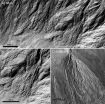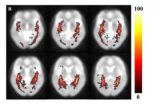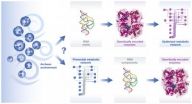(Press-News.org) Researchers at Aarhus University, Denmark, have drawn up the most detailed 'image of the enemy' to date of one of the body's most important players in the development of Parkinson's disease. This provides much greater understanding of the battle taking place when the disease occurs – knowledge that is necessary if we are to understand and treat Parkinsonism. However, it also raises an existential question because part of the conclusion is that we do not live forever!
Parkinson's disease is one of the most common neurological disorders, with about 7000 people suffering from the disease in Denmark alone. There is no cure, and the symptoms continue to get worse. The disease occurs because different nerves in the brain die. These include the nerve cells that form dopamine, which is known as the brain's 'reward substance' and which also helps control our fine motor skills.
A group of researchers from Aarhus University, the University of Southern Denmark (SDU) and the University of Cambridge has just published two studies in the prestigious Journal of the American Chemical Society (JACS) and Angewandte Chemie. These studies provide the best insight to date into the behaviour of a particular protein state that plays an important role in Parkinson's disease. In other words, they have created a detailed image of what is presumed to be the arch enemy we are up against in our understanding of Parkinsonism. It is an advanced antagonist, and one that functions with a considerable degree of unpredictability. "Fighting the enemy is by no means a Sunday outing," say the main authors of the results – Professor Daniel Otzen, Aarhus University, and his colleagues Nikolai Lorenzen and Wojciech Paslawski, who recently defended their PhD dissertations on this subject at Aarhus University's Interdisciplinary Nanoscience Centre (iNANO).
Protein aggregation kills nerve cells
Knowledge about what actually takes place in the brain when Parkinson's disease occurs and develops is absolutely necessary, not only for the prevention and treatment of symptoms, but also for possibly developing a cure one day.
However, getting to know the enemy is no easy task when it comes to understanding Parkinson's disease. The more we find out, the more complex the image becomes.
We already know that the disease – as well as other neurological disorders – arises because some protein structures in the body start clumping together. They stack themselves on top of each other and gradually form what are known as fibrils – long, thin needle-shaped structures. From a biochemical point of view, this is quite a boring process because the protein structures simply pile themselves on top of each other and – in principle – can continue to do so forever.
It is far more interesting to look at the intermediate stages leading up to the aggregation. It turns out here that when the proteins form fibrils, a kind of intermediate aggregation process also takes place to form oligomers, which consist of a small number of protein molecules that clump together. It is presumably the oligomers that kill the nerve cells and cause the symptoms of Parkinson's disease. So oligomers are the enemy we want to control.
Ground-breaking new knowledge about the enemy
In their two studies, the researchers from Aarhus University, the University of Southern Denmark and the University of Cambridge provide the most well-documented description of oligomers to date. Until now, the general perception was that oligomers were precursors of the fibrils. As it turns out, however, it is rather the antagonists or competitors of the fibrils that are the precursors, and these are capable of slowing down the formation of fibrils.
The researchers discovered that there are different kinds of oligomers. If we look at the size, there are two types that are quite intimately connected. A somewhat small oligomer that is very well defined and a larger one that is virtually a chain composed of the smaller ones. The oligomers are thus capable of linking up in the same way as the fibrils, but in chains that inhibit the fibrils. "You could say that they put a spanner in the works regarding the formation of fibrils," says Professor Otzen. It could possibly be a help to shift the focus even further away from the fibrils, which are formed in a different process than the oligomers, and which should not be a target for pharmaceutical products on their own.
Description of the enemy
So what does our adversary look like? The researchers can now help provide us with a better answer. An oligomer consists of a very stable interior and a more diffuse sphere surrounding it, where the protein is not as compact and where it flaps around a little
And yet the image is even more complicated than that! Because if you take a closer look at the little oligomer, there are also two types here. To study this, the researchers used very advanced mass spectrometric techniques carried out together by Associate Professor Thomas Jørgensen and PhD student Simon Mysling at SDU. Associate Professor Jørgensen's group consists of world experts in hydrogen-deuterium exchange (HDX), which can be used to study how flexible or loosely structured the different parts of a protein are. It turns out that two different oligomers with different degrees of flexibility can be present at the same time. One type admittedly 'flaps around' more than the other, but it is nevertheless very stable and does not turn into fibrils because it is unable to 'absorb' monomer proteins and thereby grow bigger. This oligomer simply clumps together to form larger oligomers, and is the dominating (and toxic) type, corresponding to the structure shown above. The other type (which only accounts for 10% of the total oligomer population) is capable of absorbing monomers and becoming (harmless) fibrils.
"You can't say that we've now solved the puzzle of Parkinson's disease. Of course we haven't," says Professor Otzen. "But we've come much further in our understanding of an important player in the disease. We know what it looks like, how it arises and how it affects the formation of other fibrils," he adds.
"Knowing what the enemy looks like provides us with better tools to fight it. It's a very shrewd and sneaky adversary because it combines a compact nucleus with a diffuse shell," says Professor Otzen. "We haven't yet found its Achilles heel, but we've gained a much better starting point for interpreting what happens, and understanding the substances that can bind to the oligomers. We'll be able to study whether there are substances that can jog the distribution of oligomers, for example, so that they 'suppress' the formation of the toxic oligomers and boost the formation of the harmless type that can go on to become fibrils," he concludes. This knowledge is useful in the work to develop pharmaceuticals and in the understanding of Parkinson's disease. The research can be better targeted, but based on the slogan that the more you know, the more complex things can often be. Even though we know the enemy, we do not yet know how to nail it.
The existential aspect
Back to the question of the existential aspect, because conditions like Parkinson's disease are to a great extent an expression of human progress and well-being.
What is so special about oligomers is that they have no purpose in the body. They are not designed to do anything in particular. Protein aggregation is basically an expression of a system error in the body that shows the system is getting old and tired. This means there is not necessarily a simple explanation of why the oligomers occur. In a way, they are the shady side of the proteins' ability to make beautiful structures because this also provides them with an opportunity to make wrong structures.
The fact that they start to be tricky is to a large extent a matter of getting older and older. We used to wear out earlier and we died much younger before the body's 'system error' started to play up. We can now grow to be very old, but our bodies are by no means designed to be so old. We should therefore not expect a simple explanation of why conditions like Parkinson's disease arise, even though we are now in better control of the oligomers. Parkinson's is a kind of 'wear and tear' situation and, just from our own car mechanic, we know that there are numerous different ways a car can be worn out – and the same applies here. "In a way, it's very existential. We can't live forever, and this is one explanation of why not," says Professor Otzen. "This type of thing just starts to happen when we get old, but we can hopefully postpone and minimise the consequences so that we can remain hale and hearty to an even greater extent when we reach a ripe old age," he adds.
INFORMATION:
About the studies
The JACS study involves a collaboration between Daniel Otzen's Protein Biophysics Group, headed by Professor Jan Skov Pedersen, also from iNANO at Aarhus University, working with SAXS techniques, and a group headed by Tuomas Knowles and Chris Dobson from the University of Cambridge, who work with studies of protein aggregation. The study published in Angewandte Chemie involved very close collaboration with Associate Professor Thomas Jørgensen and PhD student Simon Mysling at the University of Southern Denmark.
Know your enemy
Oligomers' role in the development of Parkinson's disease
2014-04-25
ELSE PRESS RELEASES FROM THIS DATE:
3D printing cancer tumors
2014-04-25
Drexel's Wei Sun, PhD, Albert Soffa chair professor in the College of Engineering, has devised a method for 3D printing tumors that could soon be taking cancer research out of the petri dish.
Using a mixture of cervical cancer cells and a hydrogel substance that resembles an ointment balm, Sun can print out a tumor model that can be used for studying their growth and response to treatment. This living model will give cancer researchers a better look at how tumors behave and a more accurate measure of how they respond to treatment.
"This is the first time to report ...
Study reaffirms soy-dairy protein blend increases muscle mass
2014-04-25
A new study published online in the Journal of Applied Physiology shows additional benefits of consuming a blend of soy and dairy proteins after resistance exercise for building muscle mass. Researchers from the University of Texas Medical Branch found that using a protein blend of soy, casein and whey post-workout prolongs the delivery of select amino acids to the muscle for an hour longer than using whey alone. It also shows a prolonged increase in amino acid net balance across the leg muscle during early post-exercise recovery, suggesting prolonged muscle building. ...
Nitrogen pollution, climate and land use: Why what we eat matters
2014-04-25
A new report quantifies for the first time how much our food choices affect pollutant nitrogen emissions, climate change and land-use across Europe.
The executive summary of the European Nitrogen Assessment Special Report on Nitrogen and Food, 'Nitrogen on the Table', was released today (Friday 25 April 2014). The Special report provides an assessment of what would happen if Europe were to decrease its consumption of meat and dairy products. It shows how much cutting down on meat and dairy in our diets would reduce nitrogen air and water pollution, and greenhouse gas ...
A civil war inside our cells: Scientists show how our bodies fight off 'jumping genes'
2014-04-25
ANN ARBOR, Mich. — There's a civil war going on inside every one of the 37 trillion cells in your body. Now, University of Michigan scientists have uncovered how your cells keep this war from causing too much collateral damage.
On one side of the battle: your "regular" DNA, which provides the day-to-day instructions for life. On the other side: tiny bits of rogue DNA that hide like spies between genes in your own DNA. From time to time, these rogue bits of DNA spin off a copy of themselves and "jump" to another DNA location – often causing harmful mutations when they ...
Traces of recent water on Mars
2014-04-25
The southern hemisphere of Mars is home to a crater that contains very well-preserved gullies and debris flow deposits. The geomorphological attributes of these landforms provide evidence that they were formed by the action of liquid water in geologically recent time.
Evidence of liquid water
When sediment on a slope becomes saturated with water, the mixture may become too heavy to remain in place, leading to a flow of debris and water as a single-phase unit. This is called a debris flow. Debris flows on Earth often cause significant material destruction and even human ...
Tsetse fly genetic code sequenced
2014-04-25
Scientists at the University of Liverpool have been part of a ten-year project which has successfully sequenced the genetic code of the tsetse fly – making major advances in disease control possible.
Tsetse flies are unique to Africa and can infect people bitten by them with sleeping sickness, a disease which damages the nervous system and is fatal if untreated. This kills over 250,000 people each year.
Traditional methods of control such as releasing sterile males, trapping and pesticide spraying are expensive and difficult to implement. Sleeping sickness can also ...
Quantitative volumetric analysis of the optic radiation in the normal human brain
2014-04-25
The optic radiation is a dense fiber tract that emerges from the lateral geniculate nucleus and continues to the occipital visual cortex. Especially, the optic radiation is an important fiber structure that conveys visual information from the lateral geniculate nucleus to the primary visual cortex in the occipital lobe. Current studies have focused on the anatomical characteristics of optic radiation fiber tracts in individual brains and on comparisons of the anatomical characteristics of the optic radiation fiber tracts between patient and control groups. Therefore, no ...
Climate change: Don't wait until you can feel it
2014-04-25
Washington, D.C.— Despite overwhelming scientific evidence for the impending dangers of human-made climate change, policy decisions leading to substantial emissions reduction have been slow. New work from Carnegie's Katharine Ricke and Ken Caldeira focuses on the intersection between personal and global impacts. They find that even as extreme weather events influence those who experience them to support policy to address climate change, waiting for the majority of people to live through such conditions firsthand could delay meaningful action by decades. Their findings ...
Reconstructed ancient ocean reveals secrets about the origin of life
2014-04-25
HEIDELBERG, 25 April 2014 – Researchers from the University of Cambridge have published details about how the first organisms on Earth could have become metabolically active. The results, which are reported in the journal Molecular Systems Biology, permit scientists to speculate how primitive cells learned to synthesize their organic components – the molecules that form RNA, lipids and amino acids. The findings also suggest an order for the sequence of events that led to the origin of life.
A reconstruction of Earth's earliest ocean in the laboratory revealed the spontaneous ...
Metabolism may have started in our early oceans before the origin of life
2014-04-25
The chemical reactions behind the formation of common metabolites in modern organisms could have formed spontaneously in the earth's early oceans, questioning the events thought to have led to the origin of life.
In new research funded by the Wellcome Trust, researchers at the University of Cambridge reconstructed the chemical make-up of the earth's earliest ocean in the laboratory. The team found the spontaneous occurrence of reaction sequences which in modern organisms enable the formation of molecules essential for the synthesis of metabolites such as amino acids, ...
LAST 30 PRESS RELEASES:
This new understanding of T cell receptors may improve cancer immunotherapies
A new fossil face sheds light on early migrations of ancient human ancestor
A new immunotherapy approach could work for many types of cancer
A new way to diagnose deadly lung infections and save lives
40 percent of MRI signals do not correspond to actual brain activity
How brain-inspired algorithms could drive down AI energy costs
Gum disease may be linked to plaque buildup in arteries, higher risk of major CVD events
Contrails are a major driver of aviation’s climate impact
Structure of dopamine-releasing neurons relates to the type of circuits they form for smell-processing
Reducing social isolation protects the brain in later life
Keeping the heart healthy increases longevity even after cancer
Young adults commonly mix cannabis with nicotine and tobacco
Comprehensive review illuminates tau protein's dual nature in brain health, disease, and emerging psychiatric connections
Book prepares K-12 leaders for the next public health crisis
Storms in the Southern Ocean mitigates global warming
Seals on the move: Research reveals key data for offshore development and international ecology
Sports injuries sustained during your period might be more severe
World's first successful 2 Tbit/s free-space optical communication using small optical terminals mountable on satellites and HAPS
Can intimate relationships affect your heart? New study says ‘yes’
Scalable and healable gradient textiles for multi‑scenario radiative cooling via bicomponent blow spinning
Research shows informed traders never let a good climate crisis go to waste
Intelligent XGBoost framework enhances asphalt pavement skid resistance assessment
Dual-function biomaterials for postoperative osteosarcoma: Tumor suppression and bone regeneration
New framework reveals where transport emissions concentrate in Singapore
NTP-enhanced lattice oxygen activation in Ce-Co catalysts for low-temperature soot combustion
Synergistic interface engineering in Cu-Zn-Ce catalysts for efficient CO2 hydrogenation to methanol
COVID-19 leaves a lasting mark on the human brain
Scientists use ultrasound to soften and treat cancer tumors without damaging healthy tissue
Community swimming program for Black youth boosts skills, sense of belonging, study finds
Specific depressive symptoms in midlife linked to increased dementia risk
[Press-News.org] Know your enemyOligomers' role in the development of Parkinson's disease



